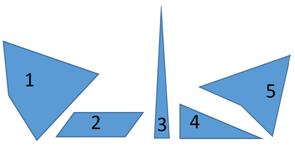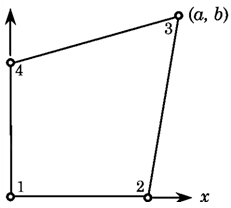This set of Finite Element Method Multiple Choice Questions & Answers (MCQs) focuses on “ Modelling Considerations”.
1. In mathematical modeling of a process, which option is not a characteristic of an analytical solution?
a) Mathematical equations are used to describe a process
b) Most practical problems cannot be solved
c) Exact information on the quantities of interest is obtained
d) Finite element method is used
View Answer
Explanation: In the development of a mathematical model, we derive the mathematical relationships governing a system. The mathematical model is often in the form of differential equations. If the relationships are simple, it is possible to obtain exact information on the quantities of interest, this is known as the analytical solution. The finite element method is not used in an analytical solution. Most practical problems are too complicated to allow analytical solutions.
2. In mathematical modeling of a process, which option is not a characteristic of a numerical solution method?
a) It does not give exact information on the quantities of interest
b) A set of assumptions are made about the process
c) Applicable to simple problems only
d) Finite element method is used
View Answer
Explanation: In the development of a mathematical model, we often make a set of assumptions about the process (e.g., constitutive behavior, loads, and boundary conditions) to derive the mathematical relationships governing the system. A numerical method, for example, the finite element method, gives an approximate solution to a given problem. Most practical problems are solved using the numerical solution method.
3. In FEM, which option is not correct with respect to the generation of element geometries?
a) It involves coordinate transformation
b) It is based on a one-to-many mapping
c) A point in actual element maps uniquely to master element
d) Tiny interior angles are avoided
View Answer
Explanation: The numerical evaluation of integrals over actual elements involves a coordinate transformation from the actual element to a master element. The transformation is acceptable if and only if every point in the actual element is mapped uniquely into a point in the master element, and vice versa. Such mappings are termed one-to-one. To avoid numerical failure of matrices, the interior angle at each vertex of a triangular element should be reasonably larger than 0°.
4. In the generation of element geometries, if dx dy represents an area element in the real element and dεdη represents the corresponding area element in the master element, then what is the expression for Jacobian je?
a) (dx dy) (dεdη)
b) \(\frac{dx}{d\epsilon} \frac{dy}{d\eta}\)
c) \(\frac{d\epsilon}{dx} \frac{d\eta}{dy}\)
d) \(\frac{1}{(dx dy) (d\epsilon d\eta)}\)
View Answer
Explanation: The numerical evaluation of integrals over actual elements involves a one-to-one mapping between the actual element and the master element. This requirement can be expressed as je>0, where je is the Jacobian matrix. Je represents the ratio of an area element in the real element to the corresponding area element in the master element.
5. In the generation of element geometries, for what value of je, the element geometries lie within the limits of acceptable distortion?
a) je>0
b) je<0
c) je=0
d) Any real value of je
View Answer
Explanation: If je is zero, then a nonzero area element in the real element is mapped into zero areas in the master element, which is unacceptable. Also, if je<0, a right-handed coordinate system is mapped into a left-handed coordinate system. In order to keep the element geometries within acceptable distortion, the je must be greater than zero, and excessive distortion is avoided.
6. Which of the following finite element geometries contains unacceptable vertex angles, in practice?

a) 1 and 2
b) 2 and 4
c) Only 3
d) 1, 3 and 5
View Answer
Explanation: The element geometries are kept within acceptable distortion and hence, excessive distortion is avoided. Some geometric shapes of real elements are also avoided. For example, the interior angle at each vertex of a triangular element should not be equal to either 0° or 180°. Indeed, in practice, the angle should reasonably be larger than 00 and smaller than 180° to avoid numerical ill-conditioning of element matrices. 1 and 5 contain too large angles, whereas 3 contains a too small angle.
7. For a finite element mesh to be valid, which option is not true regarding the elements used?
a) The number of elements used is not exact
b) Elements can be of different orders
c) Elements can be of different types
d) The choice of elements and mesh is problem-independent
View Answer
Explanation: A valid mesh can be coarse (i.e., have few elements) or refined(i.e., have many elements), and may consist of one or more orders and types of elements(e.g., linear and quadratic, triangular and quadrilateral). A judicious choice of element order and type could save computational cost while giving accurate results. It should be noted that the choice of elements and mesh is problem-dependent.
8. A finite element mesh is refined by subdividing existing elements into two or more elements of the same type, what is the name of such a refinement?
a) h-version mesh refinement
b) p-version mesh refinement
c) h, p-version mesh refinement
d) p, h-version mesh refinement
View Answer
Explanation: Refining a mesh by subdividing its existing elements into two or more elements of the same type is called the h-version mesh refinement. Alternatively, in p-version mesh refinement, the existing elements can be replaced by elements of a higher order. The h, p-version mesh refinement, in which the elements are subdivided into two or more elements in some places and replaced with higher-order elements in other places.
9. In local mesh refinement, if very small elements are placed adjacent to very large ones, then the mesh becomes unacceptable.
a) True
b) False
View Answer
Explanation: Generally, local mesh refinements should be such that very small elements are not placed adjacent to very large ones. A mesh can be coarse (i.e., have few elements) or refined (i.e., have many elements), and may consist of one or more orders and types of elements (e.g., linear and quadratic, triangular and quadrilateral).
10. In FEM, which option is the most realistic representation of the actual force between deformable bodies?
a) Point load
b) Uniformly varying load
c) Sine distribution
d) Uniformly distributed load
View Answer
Explanation: A situation where the representation of boundary forces is subject to different interpretations is found when the force is due to contact between two bodies. For example, a solid plate in contact with a circular disc generates a reactive force that can be represented either as a point load or as a locally distributed force. A sine distribution might be a more realistic representation of the actual force between deformable bodies.
11.For the following element, what is the value of a+b such that the Jacobian J=\(\frac{1}{4}\)[a(1+η)+b(1+ξ)-2(ξ+η)] is positive, where (ξ, η) are natural coordinates?

a) >2
b) <2
c) =2
d) 0
View Answer
Explanation: The point (a,b) corresponds to (1,1) in natural coordinates. Thus (ξ, η) = (1, 1).
J=\(\frac{1}{4}\)[a(1+η)+b(1+ξ)-2(ξ+η)]
=\(\frac{1}{4}\)[a(2)+b(2)-2(2)]
=\(\frac{1}{4}\)[2(a+b)-4]
=\(\frac{1}{2}\)(a+b)-1
Given j>0,
\(\frac{1}{2}\)(a+b)-1>0
\(\frac{1}{2}\)(a+b)>1
(a+b)>2.
Sanfoundry Global Education & Learning Series – Finite Element Method.
To practice all areas of Finite Element Method, here is complete set of 1000+ Multiple Choice Questions and Answers.
If you find a mistake in question / option / answer, kindly take a screenshot and email to [email protected]
- Check Mechanical Engineering Books
- Apply for Civil Engineering Internship
- Check Finite Element Method Books
- Apply for Mechanical Engineering Internship
- Practice Civil Engineering MCQs
